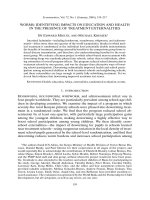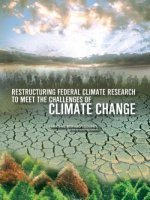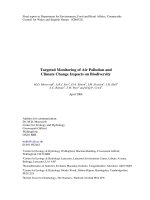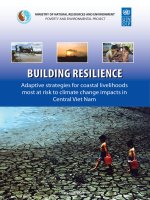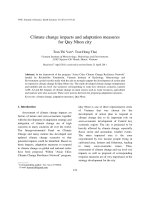Potential Climate Change Impacts on Corals and Coral Reefs in Melanesia from Bleaching Events and Ocean Acidification
Bạn đang xem bản rút gọn của tài liệu. Xem và tải ngay bản đầy đủ của tài liệu tại đây (1.52 MB, 23 trang )
CLIMATE CHANGE AND BIODIVERSITY IN MELANESIA
Series editors:
Stephen J. Leisz and J. Burke Burnett
Potential Climate Change Impacts on Corals and Coral
Reefs in Melanesia from Bleaching Events and Ocean
Acidification
Steve Coles
Department of Natural Science, Bishop Museum
CCBM Paper 5
Funding provided by:
John D. and Catherine T. MacArthur Foundation
Bishop Museum Technical Report 42(5)
June 2008
This paper is produced as part of the Climate Change and Biodiversity in Melanesia
Project, funded by the John D. and Catherine T. MacArthur Foundation. The aim of this
project is to assess the vulnerability of Melanesian marine and terrestrial ecosystems to
projected climate changes. The CCBM Paper Series, listed below, are published as part
of the larger Bishop Museum Technical Report Series.
Paper
No.
Author
Title
1
Kelvin Richards and Axel
Timmermann, IPRC, SOEST,
University of Hawaii
Climate change projections for the Southwestern
Pacific with a focus on Melanesia
2
Peter G. Brewer, Monterey Bay
Aquarium Research Institute
Climate Change and Biodiversity in Melanesia:
Biophysical science – ocean acidification
3
Dan A. Polhemus, Department of
Natural Sciences, Bishop
Museum
Climate change in New Guinea and its potential effects
on freshwater ecosystems
4
Geoffrey Hope, The Australian
National University
Palaeoecology and resilience in Melanesia: How can
palaeoecology contribute to climate change response
planning?
5
Steve Coles, Department of
Natural Sciences, Bishop
Museum
Potential Climate Change Impacts on Corals and Coral
Reefs in Melanesia from Bleaching Events and Ocean
Acidification
6
Terry J. Donaldson, University of
Guam Marine Laboratory
Climate Change and Biodiversity in Melanesia:
Implications for and impacts upon reef fishes
7
Rodney V. Salm and Elizabeth
Mcleod, The Nature Conservancy
Climate Change Impacts on Ecosystem Resilience and
MPA Management in Melanesia
8
Shelley A. James, Department of
Natural Sciences, Bishop
Museum
Climate Change Impacts on Native Plant Communities
in Melanesia
9
Andrew L. Mack, Carnegie
Museum of Natural History
Predicting the effects of climate change on Melanesian
bird populations: probing the darkness with a broken
flashlight
i
Introduction
The world’s atmosphere is undergoing changes that are unprecedented in the postglacial period of the last 10,000 years that are apparently related to the emissions which
began increasing with industrial development in the mid 19th century. Although it is only
one of a suite of “greenhouse gases” that have increased dramatically in the last 150
years, CO2 (carbon dioxide) is the most pervasive and most studied. Continuous
measurements of this compound, a natural component of the earth’s atmosphere, at the
Mauna Loa observatory on the island of Hawaii since 1958 has shown a steady
increase from an annual average of about 315 ppm to about 380 ppm in 2005 (Figure
1). Comparison of these increases with proxy records derived from ice cores indicates
that this increase is an extension of an exponential increase in CO2 from pre-industrial
levels of about 280 ppm that had been previously rising at a much slower rate from
about 260 ppm approximately 7000 years ago (IPCC 2007).
CO2 and water are essential for life’s processes, and they are the basic components for
the formation of organic matter through photosynthesis. However, increasing levels of
CO2 and other industrial emissions-related gases in the atmosphere are of major
concern, since they reduce the back radiation of heat from the earth’s lower
atmosphere, i.e. result in a “greenhouse effect” similar to a car with it’s windows closed
on a sunny day. International Panel for Climate Change estimates (IPCC 2007) indicate
that the earth’s atmosphere has warmed about 1°C since 1850, with the major portion of
this warming and the years of highest temperatures occurring in the last decade (Figure
2). A variety of IPCC models have been developed to estimate further global
atmospheric warming that may result from various estimates of atmospheric CO2
concentrations by the end of this century (Figure 3). The most conservative of these
models projects an average 2.0°C (range 1.8-2.9) above present levels, based on an
estimated pCO2 concentration of 800 ppm by 2100.
1
Figure 1. CO2 and other greenhouse gases to 2005 determined from Mauna Loa
measurements and ice core estimates. (IPCC 2007).
These increases in atmospheric temperature and CO2 concentrations are very relevant
to the earth’s ocean system since a portion of both are introduced into the ocean and
affect its physical-chemistry, biology and ecology The atmospheric warming that has
occurred since 1850 is reflected by an approximate 0.5°C in ocean temperature and a
pH reduction (acidity increase) of 0.1 to the present average pH level that averages
about 8.1, with some regional variation. Although these small changes may at first
2
Figure 2. Estimated global atmospheric temperature, seal level and northern
hemisphere snow cover 1850-2000 (IPCC 2007).
seem trivial, they have already been reflected in sometimes dramatic events related to
temperature, while increasing acidity due to elevated CO2 may have even more serious
consequences, especially in tropical regions dominated by coral reef systems.
The primary impact of elevated temperature on coral reefs is manifested as a
phenomenon known as “coral bleaching”, and the primary impact of increased ocean
acidity is on the calcium carbonate deposition and dissolution processes of corals and
other calcareous organisms that form the structure of coral reefs. Sufficient information
exists for coral bleaching and ocean acidification on reef calcifies exists so that the
impacts for these can be projected with some confidence for both the tropical oceans as
3
Figure 3. Projected atmospheric global temperature average increases from various
IPCC models (IPCC 2007).
a whole and for Melanesia as a region. A third topic to have been covered for this
project, that of diseases of corals and other marine organisms, is a science still in its
development and lacks specific information that can be projected for the tropics, with no
specific information existing for Melanesia. It will therefore not be covered here except
for this general comment and summary references (Peters 1997, Richardson 1998,
Willis et al. 2004).
Coral Bleaching
Although the awareness of coral bleaching has increased dramatically in the last 20
years because of the occurrence of a number of worldwide bleaching events, bleaching
has apparently been a natural process occurring on reefs for an indeterminate time and
was first described from observations made during the Australian Great Barrier Reef
Expedition in the late 1920s (Coles and Brown 2003). Understanding of the processes
and thresholds leading to coral bleaching was increased from work in the 1970s related
to evaluating the impact of thermal effluents from power plants (Figure 4, Jokiel and
Coles 1974) ( Coles and Jokiel 1977). Two major concepts were developed from these
studies: 1) Coral bleaching results from the combined and synergistic effects of
elevated light and temperature impacting the coral-algal symbiotic association. 2)
Threshold temperatures leading to coral bleaching are not fixed limits, but rather closely
4
tied to the ambient annual maximum temperature normally occurring in the local
environment of the coral.
Figure 4. Bleached coral in the path of the thermal outfall from the Kahe Power Station
in 1971 (Coles and Jokiel 1974).
The latter concept was derived from comparison of results of experiments and
observations comparing corals from Hawai‘i where ambient maximum temperature is
ca. 27°C with those from the mid-Pacific atoll Enewetak where annual maximum is
about 29°C. (Figure 5). These results were summarized in the statement: “in both
subtropical and tropical environments large populations of corals are exposed to
temperatures precariously close (within 1 to 2°C) to their upper lethal limit during the
summer months” (Coles, Jokiel and Lewis 1976). The existence of this 1-2°C
temperature threshold has been confirmed repeatedly in the past 30 years by
determinations derived from multiple bleaching events ranging from The Arabian Gulf,
where temperatures of 1-2°C above historic ambient maxima of 33-34°C in 1998 and
Rapa Nui (Easter Island) where a similar elevation above normal maxima of about 25°C
produced extensive coral bleaching and mortality (Coles 1983, Coles and Brown 1983).
This wide range of the temperature threshold for coral bleaching indicates a long term
acclimatization and adaptation of the processes that maintain the symbiotic association,
This is important for evaluating the potential for future adjustments to climate change
induced thermal stress. The National Oceanic and Atmospheric Administration (NOAA)
has combined this temperature threshold concept with a duration factor to develop the
“degree heating weeks” alert system which uses satellite imagery of sea surface
temperature to detect potential areas of coral bleaching Generally, a DHW value of >4-5 for an area is considered
sufficient to result in extensive coral bleaching and a DHW of 10 to correspond to
massive coral mortality.
5
Figure 5. Bleached coral on Enewetak fringing reef, 1974 (Coles unpublished).
Unfortunately rising seawater temperature in the last 30 years have coincided with
repeated major bleaching events throughout the world. Most, but not all have been
linked with years of El Nino Southern Oscillation (ENSO) (Figure 6, Hoegh-Guldberg
1999). The most dramatic of these occurred in 1998-99 when massive bleaching and
mortality occurred in the Caribbean, Indian Ocean including Indonesia, and in the
Pacific along the Great Barrier Reef and northwestern areas such as Okinawa and
Palau (Figure 7). This was the sixth major bleaching event that had occurred since
1979, with the number of reef regions where bleaching occurred increasing with time.
Figure 6. Major bleaching events occurring worldwide 1978-1999 (Hoegh-Guldberg
1999).
Interestingly, no areas in Melanesia were affected by the 1998 event, and coral
bleaching-related temperature stress appears to be more closely related to La Niña
years than El Nino in Melanesia. Three major bleaching episodes have been reported
in the Papua New Guinea (PNG) region of Melanesia since 1982 (Figure 8). The first
was a minor event in the waters of Kimbe Bay and Port Moresby (Srinivasan 2000).
The major event for PNG occurred in 1996, when four months of elevated temperatures
6
of 1.3°C above the normal maxima of about 30.5 resulted in bleaching and mortality of
54% of the corals surveyed down to 20 m (Davies et al. 1997, Foale 2006) and
bleaching was also observed in areas near Motupore and Madang and the Lihir Islands
and Lak region near New Ireland (Srinivasan 2000). In 1999-2000 increasing bleaching
with depth was observed to 20 m at some areas in Kimbe Bay and Milne Bay
(Srinivasan 2000).
Figure 7. Degree Heating Week projections for South and North Pacific during 1998 El
Nino event when extensive coral bleaching occurred outside of Melanesia.
The 1999-2000 La Nina also coincided with the most extensive bleaching event that has
been observed in the Fiji islands (Cumming et al. 2002). Moderate coral bleaching was
observed in Suva Bay in 1999 (E. R. Lovell, pers. com.) but the major bleaching
occurred in early 2000 when water temperatures exceeded normal summer maxima for
7
Figure 8. Areas of coral bleaching reported for Papua New Guinea in 1993, 1996 and
1999 (Davies et al. 1997, Srinivasan 2000, Foale 2006)
five months, with the highest temperatures occurring in March and April (Figure 9). Six
DHWs, with highest values of 30.5°C, produced >80% mortality on the southern and
eastern Fiji reefs. Coral recovery from this event was highly variable, with rapid
recovery and growth observed in Suva Harbor and Beqa Lagoon (Coles and Brown
2003, Coles pers. obs.), but long term damage was reported by J. Koven (pers. com.)
for the Great Astrolabe Reef near the Kandavu Islands.
Figure 9. Degree Heating Weeks projection for Fiji Islands region of Melanesia during
2000 La Nina belaching event. Inset: Bleached corals near the entrance to Suva
Harbor in March 2000 (Coles and Brown 2003).
8
The limited available information therefore indicates that areas of Melanesia are subject
to major coral bleaching events, but at different times than much of the Indo-Pacific
region, possibly related to La Nina rather than El Nino periods. Atmospheric and sea
surface temperature models have been developed to project the probability of coral
bleaching events throughout the 21st century. Models developed by A. Timmerman for
various reef areas around the world suggest, based upon assumed thermal thresholds
for corals of those areas and SST temperature projections, a consistent pattern
worldwide where annual temperature maxima will exceed coral bleaching temperature
tolerances by about 2030 (Heogh-Guldberg 1999) resulting in annual bleaching and
mortality that has in the past been confined to El Nino or La Nina years (Figure 10).
Projections for the western Pacific that can be used to evaluate possible future trend for
Melanesia are available in Guinotte et al. (2003). Using an annual maximum monthly
temperature of 31.1°C as a threshold for coral bleaching for the region and a projected
pCO2 atmospheric rise of 517 ppmv by 2069 (more conservative than the IPCC
estimates of 600 ppmv) their models suggest relative stability until mid 21st century and
rapid increases in temperature stress thereafter, with large areas of Melanesia subject
to annual coral bleaching (Figure 11). Similar results are shown by an unpublished
DHW model for New Guinea and Indonesia developed by A. Timmerman using IPCC
temperature projections, where DHW of 4 begins to occur in 2040-49 and DHW of >10
in 2060-69 for waters of PNG (personal communication). Further extrapolation of model
results suggests that DHW values of up to 20 could occur during the last decade of this
century.
Figure 10. Projections of annual seawater temperatures based on climate change
models developed by A. Timmerman for three reef locations worldwide (HoeghGuldberg 1999).
9
1982-
2000-
2020-
2040-
2060-
Figure 11. Projected future water temperature conditions for Melanesia. a-e: Maximum
monthly water temperatures per decade from Guinote et al. (2001) through 2069.
It should be noted that these projections are regional downscales of models developed
for worldwide or oceanic estimates and that they all have the underlying assumption
that upper thermal threshold for coral bleaching are fixed values. Clearly this is not the
case when, worldwide, temperatures inducing coral bleaching range up to nearly 10°C.
Further, when a bleaching event occurs, not all corals are affected equally and there is
a substantial interspecific and intraspecific variation in the degree to which coral
bleaching and mortality occurs for corals in the same area and subject to the same
10
stresses. Extrinsic factors such as water turbidity, circulation, shading and preexposure to elevated temperatures are a major influence on susceptibility to bleaching.
Intrinsic factors associated with both corals and their zooxanthellae are indicated to play
a major role in selection of corals that are resistant and resilient to stresses inducing
coral bleaching (Coles and Brown 2003). Guinote et al. (2001) conclude that their
projected temperatures should be within the adaptive range of corals within the region,
but if the DHW projections of Timmerman shown here by the end of the century occur,
there will be severe stress on corals of the region that will probably exceed any adaptive
mechanisms of reef corals for the region.
Acidification
CO2 is highly soluble in seawater, forming an intermediary state of carbonic acid before
disassociating to bicarbonate (HCO3-), carbonate (CO32-) and hydrogen (H+) ions. The
relative concentrations of (HCO3-) and (CO32-) are highly pH dependent, with the
Higher
proportion favoring (HCO3-) at present ocean pH of 8.1 (Figure 12).
concentrations of CO2 in the atmosphere and increased oceanic dissolved CO2 result in
increasing (H+) ions that are buffered by available (CO32-), with lower concentrations of
that ion thus available to combine with calcium ions (Ca+) for the process of
calcification. Therefore, increasing dissolved CO2 results in decreasing saturation of
dissolved calcium carbonate (CaCO3) in seawater, more energy required for deposition
of CaCO3 by calcifying organisms, and higher rates of dissolution of CaCO3 that has
already been formed.
The CaCO3 saturation state (Ω) of the oceans varies with latitude and is maximal in
tropical regions where organisms with calcareous structures predominate over those
with siliceous structures. CaCO3 is deposited by organisms in one of three crystalline
forms: calcite, aragonite and high magnesium calcite, and the saturation state of each of
these is defined by the formula:
Ω = [Ca2+] [CO32-]
k
where k is the solubility product for a given mineral phase of CaCO3. This results in Ω
saturation values of Calcite>Aragonite>high Mg Calcite at any given ocean pH.
Calcite is the dominant form of CaCO3 deposited by most tropical plankton and reefforming organisms including calcareous algae, but aragonite is deposited by reef corals
in their skeletal growth, and aragonite is generally the form referenced in demonstrating
the effects of ocean acidification. Pre-industrial aragonite Ω was estimated to have
been about 4.6, and the present value is at 4.0. It is expected that the value will be 3.1
by 2065 and 2.8 by 2100 based on IPCC pCO2 modeling estimates available prior to
1999 (Kleypas et al 1999).
11
Figure 12. Examples of reef calcifying organisms and the effect of increased CO2 on
seawater acidification and the calcification/dissolution processes. a-b: red and green
calcareous benthic algae, c: foraminifera, d-e: shallow and deep-water reef corals, f:
bryozoan, g: oysters. h: brittle star echinoderm, i: lobster (from Kleypas el 2005).
12
The anticipated result of this reduction of ocean pH and Ω saturation values in tropical
water is reduced calcification rates world-wide, especially for reef-forming corals. The
projections are based on results from controlled laboratory experiments, simulations of
atmospheric CO2 concentrations in mesocosms such as the Biosphere Project, and
mass balance calculations. Aragonite and high-calcite deposition in the tropics has
been estimated to have already decreased 6-11% from pre-industrial conditions
(Kleypas et al. 1999a), and a further decrease of 3-60% is projected for a range of
benthic organisms with a doubling of pre-industrial CO2 by about 2065 (Kleypas et al.
2001). An average 30% decline has been shown experimentally for reef coral
calcification at an Ω equivalent to double pre-industrial pCO2 values (Kleypas et al.
2005, unpublished), which could result in a 14-30% overall decrease in reef calcification
(Kleypas et al 2001). Reduced calcification rates will also result in weaker calcareous
structures and increased susceptibility to erosion, and pH reduction has been shown
experimentally to result in complete loss of coral skeletal by an apparently otherwise
healthy coral that can resume calcifying when pH is restored to normal levels (Fine and
Tchernov 2007).
These proposed reductions in reef calcification rates pose a significant potential deficit
for coral reefs world-wide, and those projected to have the greatest deficits are those in
currently high saturation conditions, e.g. the Red Sea, Caribbean and the west central
Pacific, including Melanesia (Kleypas et al. 1999a). A detailed projection for this area
for SST, calcification, and their combined effects (Guinotte et al 2003) provides a view
of possible conditions for Melanesia up through 2069 (Figure 13). Their projections may
be considered conservative since they were based on a 2060-2069 estimate of
atmospheric pCO2 of 515 ppmv, compared to the latest IPCC estimates of 600 ppmv by
that time.
The (Guinotte et al 2003) projections, based on NCAR Community Climate System
Model CCSM v. 1.0, indicate the entire Indo-Pacific region to have had optimal
aragonitic saturation (Ω>4) during pre-industrial times, but by the first decade of the 21st
century, optimal conditions to have diminished to an area eastward from Melanesia,
with most of the Melanesian region covered by adequate saturation (Ω=3.5-4) of
aragonite. Saturation conditions are projected to continue to decrease through the
second and third decade and by 2040-49 marginal (Ω=3.0–3.5) conditions are shown
for most of New Guinea and adequate saturation for the rest of Melanesia. By 2060-69
and a projected pCO2 of 517 ppmv marginal conditions are shown for all Melanesia and
all of the Indo-Pacific tropics except areas where saturation is extremely low (Ω=<3.0).
Combining temperature and saturation projection estimates shows patterns of even
greater difficulty for Melanesian and other Pacific coral reefs. Using a threshold monthly
temperature of >31.1°C for coral bleaching, by 2020-29 thermal stress is indicated to be
a factor for reefs north of the Solomon and Vanuatu Island groups, and by 2040-49 this
area expands to include waters and reefs north of PNG. By 2060-69 both thermal
stress and marginal to submarginal saturation are indicated to affect reefs throughout
most of the Melanesian region, as well as large areas throughout Indonesia and north
Australia. Therefore, by the second half of the 21st century, large reef areas in
13
Melanesia and elsewhere are projected to become marginal i.e. pushed beyond their
normal environmental limits (Keypas et al. 1999b)
Pre-1870 (pCO2=280ppmv)
2020-2029 (pCO2=415ppmv)
2040-2049 (pCO2=465ppmv)
2060-2069 (pCO2=517ppmv)
Figure 13. Projections of CACO3 saturation sat by decade through 2069 (from Guinote
et al 2003).
14
Environmental and Human Consequences of Coral Bleaching
It should be emphasized that the previous scenarios and projections are estimates
based on large-scale models and assume that rates of CO2 uptake in ocean water will
continue at present rates relative to atmospheric concentrations. This may not
necessarily be the case if higher CO32- concentrations in the water column, due to
CaCO3 dissolution, provide some increased buffering capacity in the system. This may
happen as CO2 moves closer to its saturation state in seawater with increasing pCO2
concentrations in the atmosphere. The total affect of coral bleaching and ocean
acidification by the end of the century is impossible to predict at this time and there are
large areas of uncertainty that still need to be addressed. The following are some of
these questions concerning organism and ecosystem response to bleaching and
acidification, and their resulting impacts on coral reef systems that need to be
addressed:
• Will thermal adaptation occur fast enough to counter the worst effects of coral
bleaching, and do mechanisms exist for adaptation by corals and other reef calcifiers
to reduced saturation?
• What will be the effect of elevated temperature and reduced saturation state of CO32on reef bioerosion rates? Will increased dissolution of reef materials already
deposited be an additional major factor in the total reef carbonate budget dynamics.
• The actual role of reef building in coral reef ecosystem functioning is complex and
not fully understood, and the effects of changing calcification and dissolution rates
on reef ecosystem function are unknown. If reef structures and rugosity decrease
due to climate change, will this be reflected in decreased reef biotic diversity and
biomass, especially of harvestable reef fishes?
• What will be the impact of elevated temperature and reduced saturation of CO32- on
planktonic calcifiers, meroplanktonic larval life stages and recruitment? Will more
subtle effects such as these be a major consideration in the total resulting reef
ecosystem and will such effects be widespread or localized?
• What will be the impact of all this on human populations and societies in Melanesia
and elsewhere?
A model for projected impacts of coral bleaching with various levels of acclimatization
and adaptation to coral bleaching (Figure 14) can also be extrapolated to impacts from
acidification. Depending on the frequency of the stress in the case of bleaching and the
magnitude of the change for both bleaching and acidification, different capacities to
adapt will lead to different outcomes. These could range from short term shifts in
dominant coral species from relatively mild levels of stress to worst case conditions of
long term “phase shifts” of reef dominance by fleshy macroalgae if acidification levels
proceed to where even calcite depositing calcareous algae are disfavored by
decreasing carbonate concentrations.
Even with the level of uncertainty that exists for projecting possible outcomes, if the
temperature and acidification conditions projected by the Guinotte et al. (2003) and
Timmerman models are at all realistic, it is difficult to avoid the conclusion that corals
15
and coral reef will be severely stressed by the end of the century, and that phase shifts
to algal dominated reefs are likely throughout Melanesia. What this might mean, at
Stress
Low, Intermittent
Symptom
Mechanism
Outcome
High, Frequent
Bleaching,
Recovery
Short Term Acclimatization of
Present Coral Species and/or
Phenotypes
Increased Tolerance of
Same or Similar Species
Coral Dominance
Bleaching,
Partial Mortality
Long Term Adaptation,
Selection for Tolerant Species
and/or Genotypes
Shift in Dominance to
Tolerant Coral Species
Corals and Coralline
Algae
Bleaching,
Full Mortality
Reef Coral Reduction and/or
Elimination, Coral Species
Extinctions
Phase Shifts to Macroalgal
Dominance , Reef Erosion
Macroalgae Dominance
Reef Composition
Figure 14. Model summarizing range of responses by reef corals to environmental
stresses inducing bleaching and long term changes in composition of the reef
community (In Coles and Brown 2003, adapted from Done 1999).
least initially, to practical considerations such as quantity and availability of harvestable
fish and invertebrates is uncertain, since studies following El Nino bleaching events
have shown no clear pattern of change in reef fish populations (Coles and Brown 2003).
However, over the long term, it is likely that erosion of reefs from the combined impacts
of coral beaching and acidification would decrease availability of habitat and shelter,
leading to decreases in populations of fishes and cryptic invertebrates.
Research Needs
Any model used for projecting future conditions can only be as valid as the empirical
data available to formulate and test it. SST data available from satellites has been
utilized in developing the NOAA Coral Reef Watch Satellite Bleaching Alert System.
First made available in 1997, this service provides a variety of products as well as list
server messages sent when SST models indicate that conditions are approaching or
exceeding coral bleaching thermal thresholds for a given area. The NOAA system
16
focuses on specific temperature records and alerts for 24 locations around the world,
and the only site included from Melanesia is Beqa Lagoon off northern Vitu Levu, Fiji.
Given the central location and importance of New Guinea for both Melanesia and the
Indo-Pacific, and the inclusion of the Raja Ampat Islands of west New Guinea in the
“coral triangle” of maximum species diversity for the world (Fenner 2007), the addition of
a New Guinea site to the NOAA bleaching alert system should be requested at
This would provide
specific warning information when a bleaching event was imminent, enabling the
possibity of evaluating the effects of the stress and tracking SST conditions following
the event that could be related to any recovery that might occur.
A prime candidate for the location of this requested site would be Kimbe Bay, PNG
where the Nature Conservancy (TNC) has recently completed an extensive evaluation
for the establishment of the first Marine Protected Areas (MPAs) to be implemented for
the purpose of attempting to provide resistance and resilience to coral bleaching (Salm
and McCleod, this workshop). Considerable effort and resources have been directed
toward the selection of the Kimbe Bay MPAs, and their implementation should be
supported by measurement and monitoring of parameters related to reef condition and
biotic communities.
Toolkits have been developed by both TNC (http://www.
reefresilience.org/r2coral/coral_htm/c_001.htm) and NOAA ( />activities/reef_managers_guide/welcome.html) that offer guidelines for evaluating
impacts of coral bleaching and monitoring conditions following an event. A monitoring
program should be established for Kimbe Bay and elsewhere in Melanesia where
establishment of such programs is feasible. Assessment and monitoring programs
related to coral bleaching already underway in Fiji by researchers at the University of
the South Pacific and the Reef Explorer Foundation should be encouraged to continue,
and researchers in New Caledonia contacted to determine what assessment and
monitoring programs are underway or could be established there.
Implications for Natural Resource Management in Melanesia
The indigenous people of the Melanesian area are intimately dependent on the natural
services that corals reefs provide to those living on or near the shoreline in tropical
island areas. Reefs provide a large portion of their diet, sources of some of the
materials needed for making tools and shelter, and recreation opportunities. The
culture of these societies is often closely intertwined with reef-related activities. No
other populations will be more affected by the climate change-related issues of sea level
rise, coral bleaching and ocean acidification that are likely to reduce the protection of
shorelines and natural services that have been provided by healthy coral reefs. Given
the projections of sea level rise and ocean acidification effect that have been made, it is
likely that these will be of major consequence for Melanesian nearshore populations,
and that little can be done to counter these effects even if carbon emissions and other
greenhouse gases are brought under control in this century (Pittock. 1999). With regard
to coral bleaching, the establishment of the Kimbe Bay MPAs will put Melanesia at the
forefront of a developing effort to reduce the long term impacts of coral bleaching by
selecting for factors within the MPA that could mitigate coral bleaching impact, and
17
optimize conditions for coral reef recovery even if sources of climate change are beyond
our control within meaningful timeframes (Salm and Coles 2001). Evaluation of this
effort after its implementation and the extension of successful concepts to other
protected areas will hopefully provide some amelioration of the most damaging impacts
of coral bleaching on coral reef ecosystems in Melanesia and elsewhere.
References
Coles, S. L. 2003. Coral species diversity in the Arabian Gulf and the Gulf of Oman: a
comparison to the Indo-Pacific region. Atoll Res. Bull. No. 507.
Coles, S. L and Brown, B.E. 2003. Coral bleaching: capacity for acclimatization and
adaptation. Adv. Mar. Biol, 46:183-223.
Coles, S. L. and Jokiel, P. L. 1978. Synergistic effects of temperature, light and salinity
on the coral Montipora verrucosa. Marine Biology 49:187-195.
Coles, S. L., Jokiel, P. L. and Lewis, C. R. 1976. Thermal tolerance in tropical versus
subtropical Pacific corals. Pacific Science 30:159-166.
Cumming, R. L., Toscano, M. A., Lovell, E. R. Carlson, B. A., Dulvy, N. K., Hughes, A.,
Koven, J. F., Quinn, N. J., Sykes, H. R., Taylor, O. J. S. and D. Vaughan. 2002.
Mass bleaching in the Fiji Islands, 2000. Proc. 9th Inter. Coral Reef Sympos. Bali,
Vol. 2:1161-1167.
Davies, J. M., Dunne, R. P. and Brown, B. E. 1997. Coral bleaching and elevated seawater temperature in Milne Bay Province, Papua New Guinea, 1996. Mar.
Freshwater Res. 48:513-516.
Fenner, D. 2007. The ecology of Papuan coral reefs. Chap. 5.2, p.771-799, In: Marshall,
A. J and Beehler, B. M. (eds.) The Ecology of Papua Vol. 2.
Fine, M. and Tchernov, D. 2007 Scleractinian coral species and survive and recover
from decalcification. Science 315:1811.
Foale, S. J. 2006. The scale and epistemology of coral bleaching in Papua New Guinea.
Bridging Scales and Epistemologies. Alexandria: Millennium Ecosystem
Assessment.
Guinote, J. M., Buddemeier, R. W. Kleypas, J. A. 2003. Future coral reef habitat
marginality: temporal and spatial effects of climate change in the Pacific basin. Coral
Reefs 22: 551-558.
Hoegh-Guldberg, O. 1999. Climate change coral bleaching and the future of the world’s
coral reefs. Mar. Freshwater Res. 50:839-66.
IPCC. 2007. Summary for policymakers. In: Climate Change 2007: The Physical
Science Basis. Contribution of Working Group 1 to the Fourth Report of the
Intergovernmental Panel on Climate Change (Solomon, S., Qin, D., Manning, M.,
Chen, Z, Marquis, M., Averyt, K. B., Tignor, M. ans Miller, H. L. (eds.) Cambridge
univ. Press, Cambridge, U. K. and New York.
Jokiel, P. L. and Coles, S. L. 1974. Observations on the biotic effects of heated effluent
from the Kahe Power Plant, Kahe Point, Oahu. Pacific Science 28:1-18.
Kleypas, J. A., Buddemeier, R.W., Archer, D., Gattuso, J. P, Langdon, C., Opdyke, B.
N. 1999a Geochemical consequences of increased atmospheric carbon dioxide
on coral reefs. Science 284: 118-120
18
Kleypas, J. A., McManus, J. W. Lambert, A., Menez, B. 1999b. Environmental limits to
coral reef development: where do we draw the line? Amer. Zool. 39: 146-159.
Kleypas, J. A., Buddemeier and Gattuso, J. P, 2001. The future of coral reefs in an age
of global change. Int. J. Earth Sci. 90:426-437.
Kleypas, J. A,, Feely, R. A. , Fabry, V. J., Langdon, C. L., Sabine, C. L. and Robbins, L.
L. 2006. Impacts of Increasing Ocean Acidification on Coral Reefs and Other Marine
Calcifiers: A Guide for Future Research, report of a workshop held 18–20 April 2005,
St. Petersburg, FL. sponsored by NSF, NOAA, and the U.S. Geological Survey.
Peters, E. C. 1997. Diseases of coral-reef organisms. In: Birkeland C. (Ed), Life and
Death of Coral Reefs. Chapman and Hall, NY, pp. 114-139.
Pittock, A. B. 1999. Coral reefs an environmental change: adaptation to what? Amer.
Zool. 39:10-29.
Richardson, L. L. 1998. Coral diseases: what is really known? Trends in Ecology and
Evolution 13:438-443.
Srinivason, M. 2000. Coral bleaching and environmental change. Chap 6 In: The Status
of Coral reefs in New Guinea. Global Cpral Reef Monitoring Network, Australian
Institute of Marine Science, Townsville, Australia.
Salm, R. V and Coles, S. L. (eds.) Coral Bleaching and Marine Protected Areas.
Proceedings of the Workshop on Mitigating Coral Bleaching Impact Through MPA
Design. Bishop Museum, Honolulu, 29-31May, 2001. Asia Pacific Coastal Marine
Program Report No. 0102, The Nature Conservancy, Honolulu: 118 pp.
Willis, B.L., Page, C. A. and Dinsdale, E. A. 2004 Coral disease on the Great Barrier
Reef. In: Rosenberg E, Loya Y (Eds). Springer, Berlin. pp 69-104
Wilkinson, C., Lindon, O., Cesar, H., Hodgson, G., Rubens, J. and Strong, A. E. 1999.
Ecological and sociological impacts of 1998 coral mortality in the Indian Ocean: an
ENSO impact and warning of future change? Ambio 28: 188-196.
19





